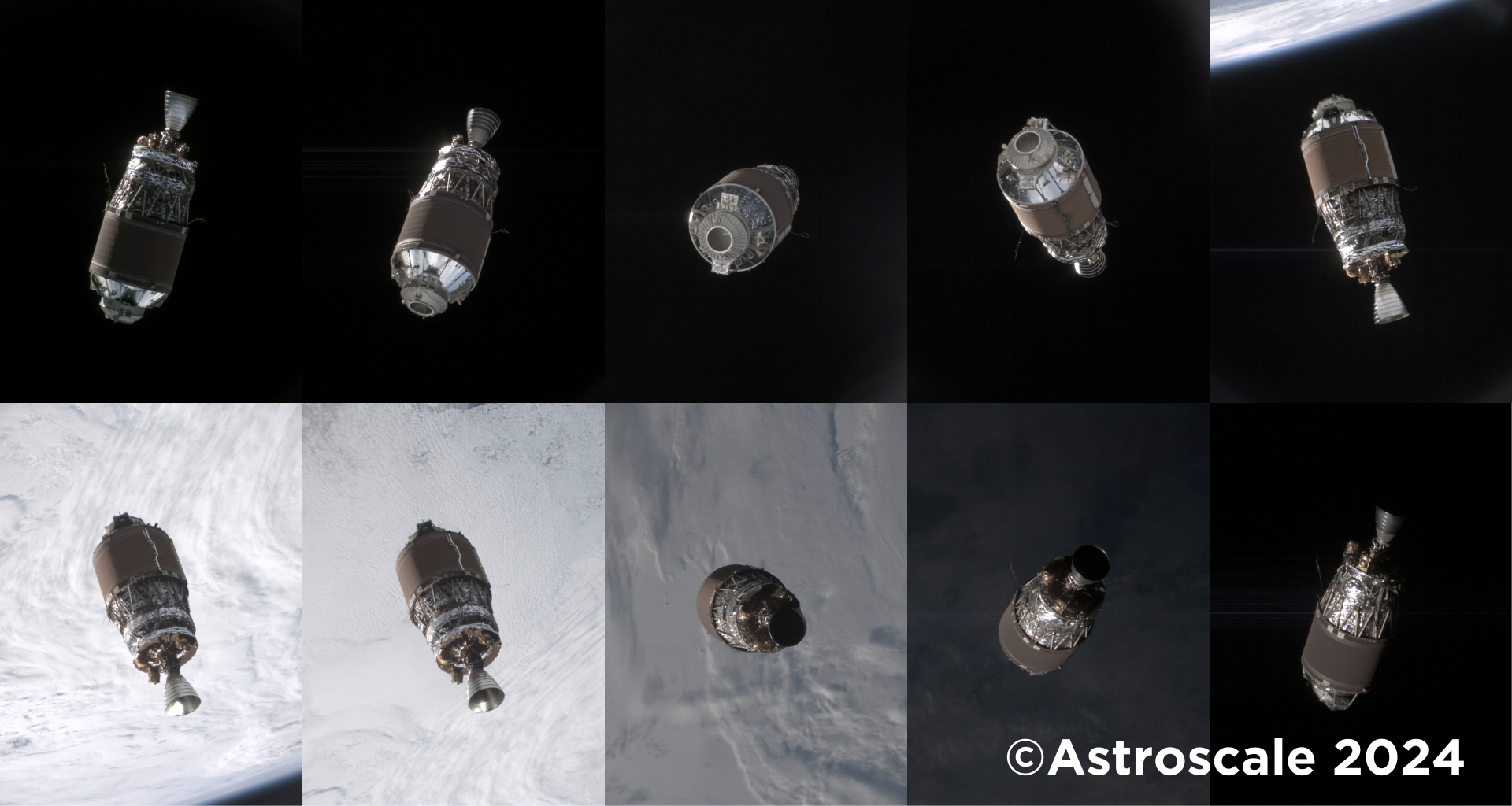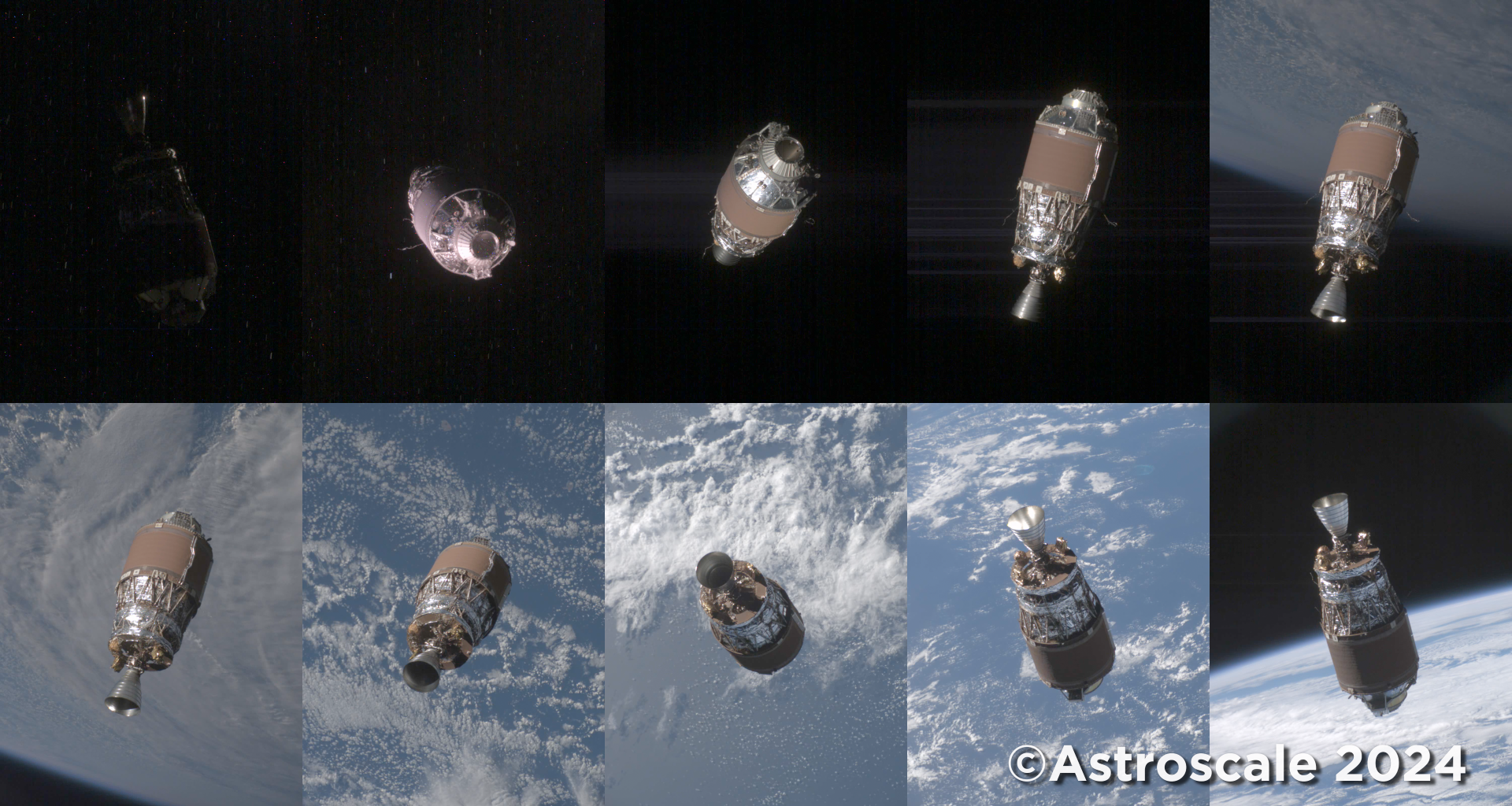CRD2 Phase I / ADRAS-J Update: Fly-Around Observation Images of Space Debris Released
July 30, 2024 (JST)
Japan Aerospace Exploration Agency (JAXA)
The Japan Aerospace Exploration Agency (JAXA) has advanced the Commercial Removal of Debris Demonstration (CRD2) (*1) Phase I project. Under this initiative, the demonstration satellite ADRAS-J (*2), developed by Astroscale Japan Inc., has successfully captured images of space debris, a non-cooperative target (*3), through "Fly-around observation." These images have now been released by Astroscale Japan Inc.

Figure 1: Images of the target space debris taken during the "Fly-around observation" on July 15th 2024. The order of the images progresses from top left to bottom right.
(H-IIA upper stage, which launched Greenhouse Gases Observing Satellite (GOSAT), also known as Ibuki in 2009, H2A R/B, International Designator: 2009-002J, Catalog Number: 33500, the bottom of the image is toward the nadir direction).

Figure 2: Images of the target space debris taken during the "Fly-around observation" on July 16th 2024. The order of the images progresses from top left to bottom right.
(H-IIA upper stage, which launched Greenhouse Gases Observing Satellite (GOSAT), also known as Ibuki in 2009, H2A R/B, International Designator: 2009-002J, Catalog Number: 33500, the bottom of the image is toward the nadir direction).
The “Fly-around observation service” is the third of the four services (*4) required by JAXA in CRD2 Phase I. This service involves pointing a camera at the target debris, maintaining a constant distance from it, and orbiting around the target debris to capture images from different directions.
On July 15 and 16, 2024, ADRAS-J, operated by Astroscale Japan Inc., successfully carried out the “Fly-around observation service” in compliance with the safety requirements set by JAXA (JERG-2-026 Safety Standards for On-Orbit Servicing Missions (*5)). The distance to the target debris was approximately 50 meters. As a result, a series of images shown in Figures 1 and 2 were successfully captured. In these images, the target debris appears almost stationary with the PAF pointing in the nadir direction, while ADRAS-J moves around and takes images.
The specifications for the "Fly-around observation service" are designed to obtain high-quality images and sufficient data to reveal the motion, damage, and degradation of long-orbiting debris, which is globally scarce information. These specifications have been carefully developed based on JAXA's technical expertise, ensuring their feasibility. By providing this service, the contracted company acquires Rendezvous and Proximity Operations (RPO) technologies applicable to a wide range of on-orbit services, including active debris removal.
In on-orbit services, it is necessary to control the relative position and attitude of the servicer to get around to a specific part of the target to observe or perform some task on it. There are several technical challenges in achieving this for non-cooperative targets, including the detailed shape and surface reflectance of the real target object, which is not known in advance, the changing visibility of the target object, and the influence of earth-reflected light, which disturbs the navigation sensor (the so-called earth background problem in non-cooperative relative navigation). This is a technically challenging mission, as the servicer spacecraft must overcome these challenges for relative navigation while achieving highly accurate relative six-degree-of-freedom control.
The successful safe completion of this service by ADRAS-J marks a steady step towards achieving CRD2's two objectives: acquiring debris removal technology to improve the increasingly serious space debris problem and enhancing the competitiveness of Japanese companies in the on-orbit services market.
The images in Figures 1 and 2 allowed us to see the surface appearance of the entire target debris, not just the sides visible during the previous “Fixed-point observation service.” Additionally, the PAF of the upper stage of the rocket and its surroundings, which are the target part to be grabbed during CRD2 Phase II, were identified in detail after 15 years in orbit. The string-like objects observed on either side of the body are presumed to be surface protection tapes, also seen in the launch operation images. These observations provide critical insights for designing and validating the capture system for the upcoming CRD2 Phase II.
Astroscale Japan Inc. will continue to operate ADRAS-J and will firstly carry out “Astroscale missions”, which are planned and carried out by the company itself. Next, as the last of the four “services” required by JAXA, the “Mission termination service” (transfer to a safe orbit without colliding with the target) will be carried out. JAXA has provided extensive technical advice, testing facilities, and research intellectual property, focusing on on-orbit rendezvous, supporting ADRAS-J's development and operation. Moving forward, JAXA will continue to provide technical support for ADRAS-J operations and conduct a detailed analysis of the obtained images.
*1: Commercial Removal of Debris Demonstration (CRD2)
The Commercial Removal of Debris Demonstration (CRD2) is a new initiative by JAXA to acquire active debris removal technology to address the escalating space debris problem and support the commercial activities of the Japanese companies. Astroscale Japan Inc. has been selected as the contract partner for Phase I of the CRD2. In this project, JAXA provides technical advice, test facilities, intellectual properties of research results to support the selected companies.
CRD2 web: https://www.kenkai.jaxa.jp/eng/crd2/project/
*2: ADRAS-J
CRD2 Phase I demonstration satellite developed, owned and operated by Astroscale Japan Inc.
*3: Non-cooperative target
A non-cooperative target refers to a space object that lacks certain features and equipment, such as attitude control functions, communication capabilities, GPS receivers, laser reflectors, image processing markers, and docking mechanisms, which are essential for facilitating its approach or capture by another spacecraft. The absence of these elements significantly increases the technical challenges involved in approaching or capturing such targets, especially when compared to objects that are equipped with these features, like the International Space Station.
*4: JAXA's Required Services in CRD2 Phase I
The four required services are "Rendezvous performance reporting service," "Fixed-point observation service," "Fly-around observation service," and "Mission termination service."
CRD2 web: https://www.kenkai.jaxa.jp/eng/crd2/project/
*5: JERG-2-026 Safety Standard for On-Orbit Servicing Missions
The standard outlines the basic requirements that should be taken into consideration for service satellites to avoid collisions that could lead to significant debris generation or the service satellite becoming debris itself during operations involving close approach, contact, or docking with other client satellites or objects.
*6: PAF
Abbreviation for Payload Attach Fitting. Structure of the satellite separation section, which is the mounting base connecting the launch vehicle and the satellite. Due to its shape and structural stability, it is considered to be a target part of the capture in CRD 2 Phase II.